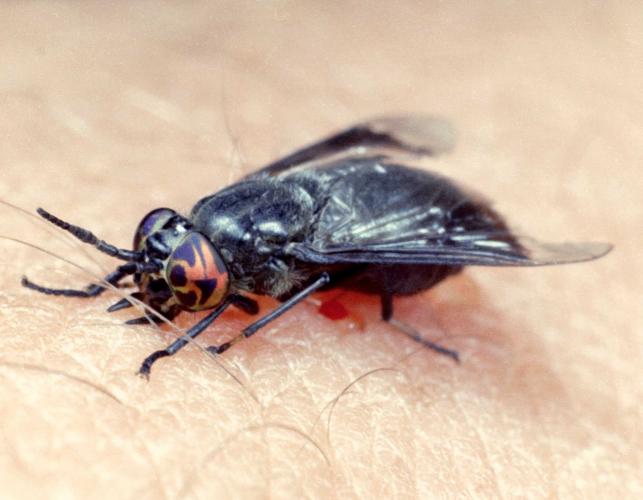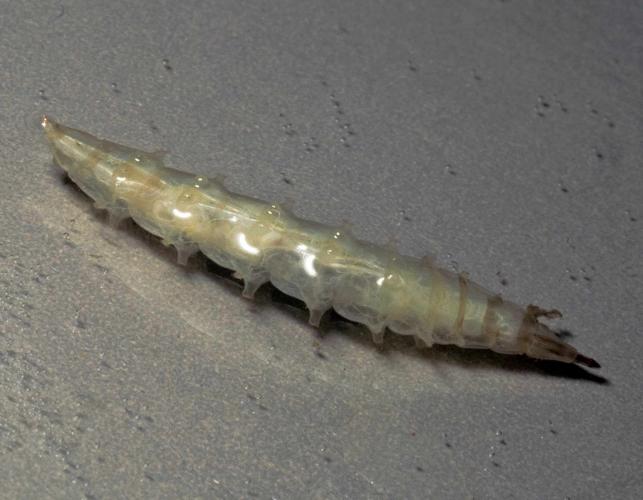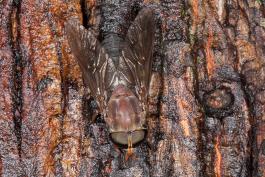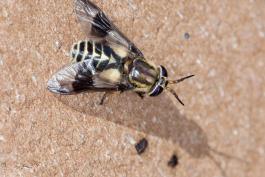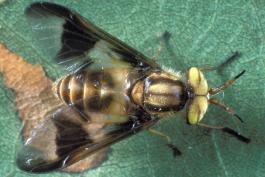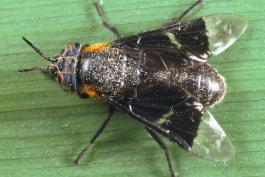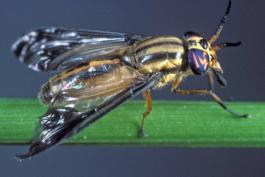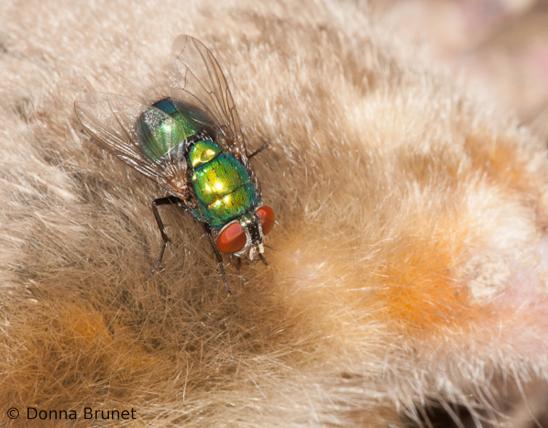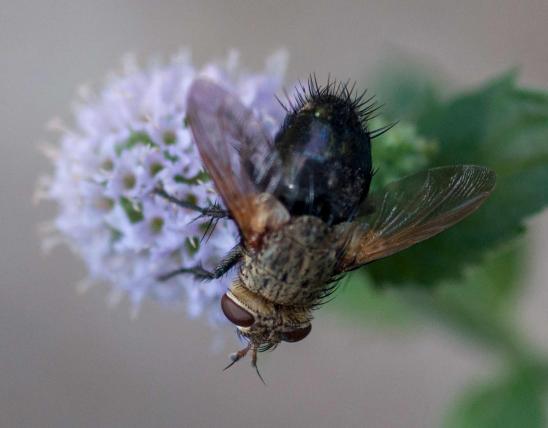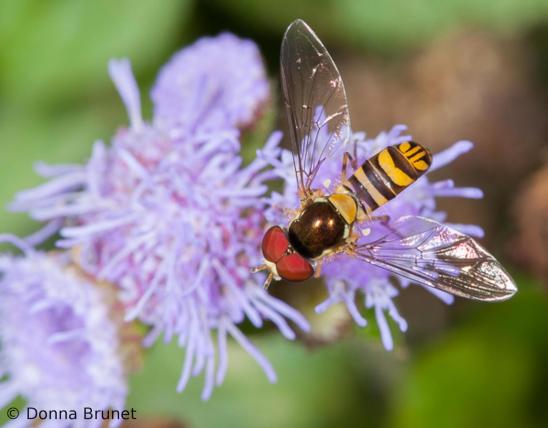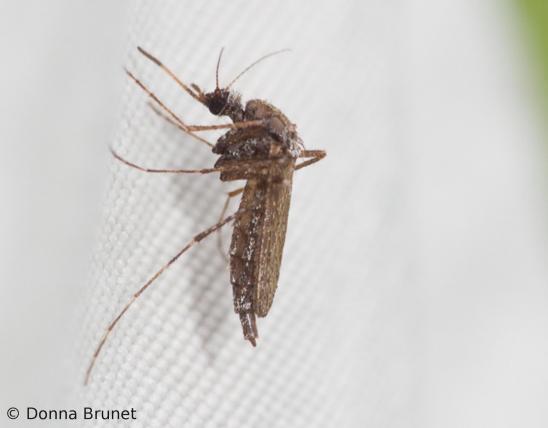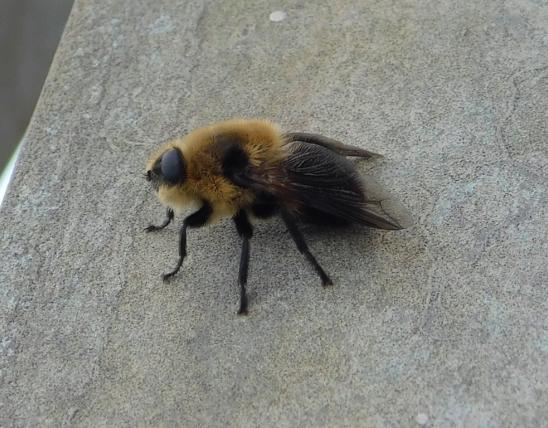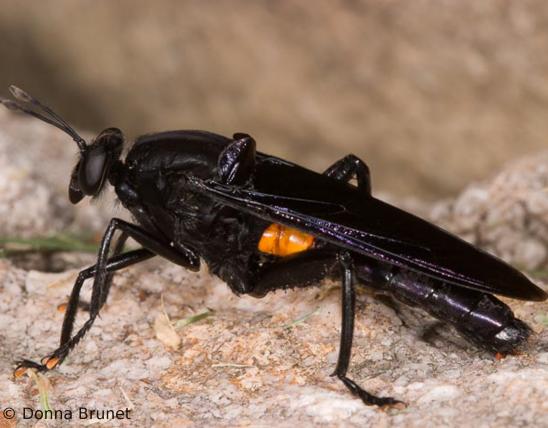
Horse and deer flies belong to the same family, and there are about 350 species of them in North America north of Mexico. Like other true flies, they have only one pair of wings, short antennae, and large compound eyes. Distinguishing them from other kinds of flies, horse and deer flies are stout and usually medium to large. Overall, most are drab browns, grays, and blacks, but many species have bright, iridescent, or rainbow-colored eyes, sometimes with spots or stripes. Horse and deer flies are notorious for drinking blood from cuts they make into their host’s skin.
Females drink the blood of vertebrates, while males do not. In both deer flies and horse flies, there is a space between the eyes in the females (when viewed from above), while the eyes of males nearly touch.
The larvae are fairly straight, segmented, wormlike maggots that are tan, whitish, or brownish. They are aquatic or live in mud, and most are predaceous.
Key identifiers for adults in this family of true flies:
- Stout flies, usually medium to large.
- Overall color usually drab brown, gray, or black.
- Only one pair of wings.
- Antennae short.
- Eyes large, compound, sometimes bright, iridescent, or rainbow-colored, sometimes with spots or stripes.
- Females drink blood from cuts they make in their host’s skin.
- Deer flies: usually smaller than horse flies; often have spotted eyes and a dark-spotted pattern on the wings.
- Horse flies: usually larger than deer flies; usually have solid or striped eyes.
There are three subfamilies in family Tabanidae:
- Chrysopsinae, the deer flies, with about 120 species in North America north of Mexico. Deer flies range from less than ¼ to about ¾ inch, so they are usually smaller than horse flies, and they often have spotted eyes and a dark-spotted pattern on the wings. Chrysops is a common genus.
- Tabaninae, the horse flies, with more than 200 species in North America north of Mexico. Horse flies can be more than 1 inch long, so they can be larger than deer flies. Also, they usually have solid or striped eyes. Tabanus is a common genus.
- Pangoniinae, a less-famous group with no common name, has about 27 species in North America north of Mexico; species in this subfamily apparently rarely, if ever, drink blood. Adults usually get their nutrients from visiting flowers. Most in this subfamily are western species, but some are found in the eastern United States, including Missouri. Stonemyia tranquilla is one species that might be found in our state.
Length: ½ to 1 inch; horse flies are usually larger than deer flies (varies with species).

Statewide.
Habitat and Conservation
Adults, being strong fliers, can be found nearly anywhere. They are most common near streams and wetlands, where the females will lay eggs. Females are also common around cattle, horses, deer, and other large mammals, from which they obtain the blood needed in order to make eggs.
Female horse and deer flies are attracted to large, moving, dark objects, which in nature could easily lead them to a deer, horse, or other large mammal. But it can also cause them to be attracted to cars and other vehicles (or you). If you park near a wetland or stream, don't be surprised if your vehicle is bombarded by horse flies.
Most larvae are aquatic, living in streams, on the edges of ponds, or in wetlands, where they prey on insects and other small animals or (in some species) feed on detritus.
Food
Adults eat nectar and pollen from flowers. Females (but not males) also drink blood. They are attracted to large, dark, moving objects. They land softly on a vertebrate (such as a cow or a person), then use mouthparts that are like a pair of scalpels, which they slide back and forth like scissors to make an incision into the skin. They lap up the blood that seeps from the wound. Their saliva contains anticoagulants to keep the blood flowing. The larvae are voracious predators of other small animals, including insects, small fish, and more.
Status
Common. Horse and deer flies are pests of horses, cattle, and other livestock, not only for the pain and frustration they cause for the animals, but also for the diseases they occasionally transmit. Because the wounds can keep bleeding long after the fly’s had its blood meal, an animal that’s been attacked multiple times can experience significant blood loss.
Life Cycle
These, like all other members of the fly family, go through complete metamorphosis, starting out as eggs, which hatch into grublike or caterpillar-like larvae, which pupate and then emerge as winged adults capable of reproducing. In horse and deer flies, mating swarms result in fertilized females, which lay eggs on plants or other objects overhanging water. The larvae live — sometimes for years — in water, then pupate and become creatures of the air.
Human Connections
Tularemia is just one disease that can be transmitted by these flies, though the most common problems they cause for people and livestock are painful, itchy welts. Because they are such determined attackers, they often don’t leave when swatted at.
Missouri history, and Midwest history, has many examples of places that were deemed unfit for settlement due to the presence of so-called green-head flies, also called green flies or green-headed flies. These refer to deer and horseflies, whose heads appear green because of their large iridescent eyes. For example, in the 1800s, the upland prairies of Missouri's Audrain County were late to be settled in large part due to the presence of these insects. The WPA-produced Missouri: A Guide to the "Show-Me" State (1941) put it this way: "At certain times of the year, the flies made day travel impossible, and even plowing and other farm work had to be done at night." Many other prairie regions in the American Midwest had similar problems with tabanid flies; in some cases, horses were said to be driven mad by the incessant attacks of horse and deer flies.
Ozark folklorist Vance Randolph noted that some of the oldtime Ozarkers he met believed that "horse flies somehow hatch out of frog spit," that is, the bubble homes of spittlebugs that appear on the stems of plants. It's one of many curious beliefs and superstitions he recorded.
Ecosystem Connections
The larvae help control populations of the many small animals they eat. The adults of some species are important pollinators. Several predators, including insectivorous birds, eat them, and certain wasps parasitize them. The horse guard wasp stings horse flies and uses them to feed its larvae.
Tabanid flies occur nearly worldwide, and one of the reasons why horses have such long tails is to help sweep these flies from their bodies.



